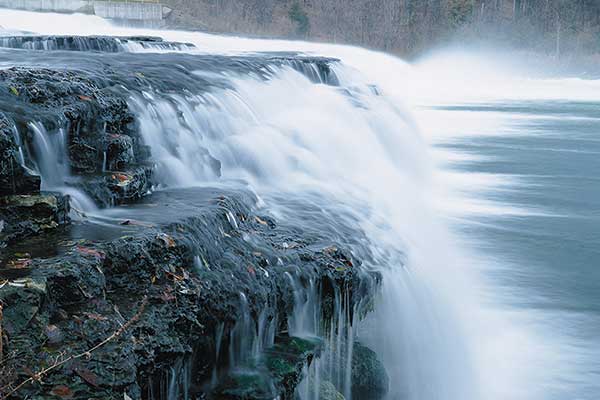
Guest Blog post by Mark Harris, the author of Waterfalls of Ontario.
Photo credits: George Fischer
Ontario’s waterfalls are special places. Found in all corners of our province, they are great spots for hiking, photography, family outings or to just spend some quiet time in nature.
As a hobby, ‘waterfalling’ has grown in popularity in recent years. Whether it’s just a short walk to a falls in your neighbourhood, or an overnight trip to a far corner of Ontario, this a great way to explore your province, spend locally, and get some fresh air and exercise.
The new, updated and expanded 4th edition of Waterfalls of Ontario is a resource that people can use to find out where waterfalls are located by region and to learn about what to expect before heading to their destination.
Most waterfall fanatics get their start at Niagara Falls. Our most famous falls is formed where the Niagara River blasts over the side of the Niagara Escarpment. The Escarpment is a high rock cliff formed where a harder rock layer called dolostone protrudes over a softer, more easily-eroded layer of shale. This allows the river to fall vertically 53 m to the plunge pool below.
From Niagara, the Escarpment winds its way west to Hamilton and then north to the Bruce Peninsula. Other streams that encounter the Escarpment also form waterfalls. And even though these are much smaller than Niagara Falls, they can be more approachable, and just as enjoyable.
Balls Falls, near St Catharines, is a great first waterfall to visit after Niagara. A visitors’ centre, small pioneer village and well-marked hiking trails make for a great afternoon. The beautiful falls are the star of the show, of course. And this site comes with a bonus… two falls for the price of one! This is because in some places along the Escarpment, there are two separate resistant layers of harder rock. Each one creates a beautiful falls.
A little further west, in Hamilton, so many streams form waterfalls as they drain over the Escarpment that the city has billed itself as the ‘Waterfall Capital of the World’. To be fair, many of these falls are very small, and like Balls Falls and others in southern Ontario, many are often dry through the summer. Still, bigger beautiful examples like Albion Falls, Sherman Falls, or Tiffany Falls are busy attractions that generally flow year-round. (Pro Tip: try to visit smaller waterfalls in spring, when stream flow is highest).
Even more scenic waterfalls are located along the Escarpment as it winds its way north. Inglis Falls, Indian Falls and Jones Falls are all developed for visiting and are easily accessed from Owen Sound. Inglis Falls, like some other larger falls, requires a small entry fee. Please pay; it helps to control crowding and maintain the park.
In Eastern Ontario, much of the landscape is underlain by flat limestone. Lacking a big, bold landform like the Niagara Escarpment, most of the waterfalls here are shorter. Yet the larger rivers in this region can still result in broad, inspiring waterfalls. Healey Falls or Ranney Falls, for example, both put on a good show during spring melt. Smaller, but attractive falls are easily visited at Almonte and Pakenham. A taller example is found at Rideau Falls, just a modest walk from Parliament Hill in Ottawa.
As we move out of southern Ontario, it is impossible not to notice the shift to the rocky Canadian Shield landscape. Water and exposed bedrock are everywhere, which, of course, means lots of opportunities for waterfalls!
Instead of the alternating layers of hard and soft rock that we see in southern Ontario, the Canadian Shield is dominated by rocks like granite and gneiss. These are all hard, which is why we don’t see the vertical “plunge”-style waterfalls that form on the flat rocks in southern Ontario.
Much more common in the north are “cascades” which occur where a river flows over a rocky slope. Onaping High Falls near Sudbury is a perfect example of a slope cascade, where the Onaping River follows a more gently-sloped, yet chaotic route down the side of a large hill.
Does this mean that the waterfalls in northern Ontario are less spectacular? No way! Even if they are rarely vertical, northern falls on big rivers can be raging monsters during spring melt. Many waterfallers find that the longer, tortuous shape can make northern cascades more fun to explore. With lots of nooks and crannies, their appearance varies as stream and river levels rise and fall through the season.
Many southerners get their first glimpse of “northern” waterfalls in cottage country. Bracebridge Falls, Wilsons Falls and High Falls are all easily accessed at Bracebridge. The first one is found right in town and allows for a more ‘civilized’ experience. Wilsons Falls offers great hiking, while High Falls is the largest and is joined by two smaller bonus waterfalls just a few steps into the woods.
Other great waterfalls are found throughout cottage country. Some, like Brooks Falls near Emsdale or Fenelon Falls, are right off the highway and are accessible to everyone. Others, like Egan Chute just east of Bancroft, or High Falls, near the southern tip of Algonquin Park, require a 15-20 minute hike into the wilderness. Just right for the novice explorer.
Some of the real “hidden gems” can only be reached after a long hike or a long paddle. Dozens of waterfalls in Algonquin Park, for example, can only be reached after a challenging canoe trip.
Highway 17, which runs from Ottawa to Thunder Bay and beyond, can be considered to be Ontario’s “Main Street” for waterfalls. The highway provides easy access to many of our biggest and most scenic falls. People living in northern Ontario know that the highway also serves as a springboard for more remote falls that are more challenging to visit.
In the ‘Waterfalls of Ontario’ community on Facebook, it is a rite of passage for many southerners to make the “Thunder Run”; a multi-day waterfall trip to Thunder Bay and back again. So many waterfalls are found along the route that people have planned and enjoyed week-long, waterfall-centred vacations. A shorter 3-day version of the trip can include a turnaround at Wawa. Highlights along Highway 17 include Duchesnay Falls at North Bay, Chutes Provincial Park at Massey and Crystal Falls at Sault Ste Marie. Chippewa Falls and Sand River Falls are all easily reached right off the side of the highway, and at Wawa, Magpie Falls and Silver Falls should not be missed.
Anyone passing through Thunder Bay usually stops at Kakabeka Falls. Known as the ‘Niagara of the North’, this 40 metre high, near-vertical falls is right off the highway and is surrounded by viewing platforms. Perhaps equally as impressive, but much less busy, is High Falls on the Pigeon River. Found at the end of a 15-minute hike, this is great afternoon excursion from Thunder Bay.
Great waterfalling also exists in north-eastern Ontario. This includes a good cluster of wild but easily-accessible waterfalls in the Timiskaming area, north of North Bay. A three-day loop trip from southern Ontario can take you to a provincial highlights like Kap-Kig-Iwan Falls near New Liskeard; aside from the main falls, there are no fewer than 6 smaller waterfalls in the same park. Adding an extra day to your trip takes you to Timmins and back, providing access to Grassy High Falls and others.
Whether visiting alone or with the whole family, you need to take a few precautions at waterfalls. While they can be completely safe to visit, there are risks to the visitor. Sadly, over the years, people have lost their lives at many waterfalls across Ontario.
Steep cliffs, rushing water and slippery rocks combine to create a safety hazard. Protect yourself by staying on the trails and behind safety railings. Sites that are less popular or more remote may be completely undeveloped for visitors. You are responsible for your own safety…”If in doubt, stay out!”
Many people ask about swimming at waterfalls, and my response is always as follows…”Waterfalls are not water parks.” These wild spaces are not engineered or safety checked. Cracks in the rock, hidden under fast flowing water can grab a foot and hold it, spelling disaster for the unsuspecting swimmer. Always ask a local for advice before swimming or wading.
Remember also that some waterfalls are found on private property. Some landowners tolerate respectful visitors, but this is their decision to make, not yours! Land ownership and access rules can change over time. Thus, even if you are following a guidebook or using a tip from social media, you must respect signs telling you to “keep out”, etc. Unwanted trespassing ruins our hobby. Fortunately, the vast majority of our falls are located on public lands.
Being a responsible waterfaller is easy, but is crucial to keeping our falls accessible. Stay on the trail, don’t put yourself at risk, take out what you bring in, and have courtesy for your fellow visitors. Sadly, some of our nicest waterfalls were temporarily closed due to overcrowding and bad behaviour during the Covid-19 lockdowns. Please do your part.
Waterfalls of Ontario, 4th Edition by Mark Harris and George Fischer was first published by Firefly Books in 2003 and is now in its fourth edition. Using its maps, photos, descriptions and directions, many readers grab the book and visit the falls in person; others enjoy virtual visits from their favourite reading chair. The website, waterfallsofontario.com, provides even more resources for the explorer. You can also join a Facebook group community to share photos and get updates.
Get out there and explore your province!








